Working safely with explosives

An open rock quarry stretches over four hectares, 12 metres below sea level at its deepest. Jukka Kinnunen and Heikki Thil explain how a sturdy pit is excavated safely for the foundations of 20–35-story skyscrapers at the construction site in Kalasatama, Helsinki.
A grey granite landscape spreads all around. The rock dust from a blasting explosion settles in a few minutes. Big earthmovers and caterpillars are moving back and forth in the area.
We are some two kilometres from the Helsinki Central Railway Station, right in the middle of Finland’s biggest ever metropolitan construction site.
In 2023 this will be the site of Redi, the country’s first skyscraper city: six residential towers and between them an office tower and a hotel. Finland’s tallest building will be 132 metres high. The biggest mal and recreation centre of the metropolitan area, offering jobs to hundreds of people, will spread at the foot of the towers, surrounded by parks and a shoreline promenade.
In autumn 2015 the excavation proceeds at a speed of two to five blasts daily, ripping out 10–2000 cubic metres of rock per blast. Up to seven drilling units at a time have drilled the holes for the explosives, and every day trucks carry away nearly 200 loads of rock to be crushed and recycled.
When the land construction phase will be over in 2016, a total of 700 kilometres of holes will have been drilled. Altogether 900,000 cubic metres of rock, the volume of which corresponds to about eight parliament buildings, will have been removed from the site.
Minute-to-minute scheduling is a must for safety
Against the blue sky, a single metro track supported by pillars looks like a futuristic city vision of the early 19th century. Every few minutes a train stops at the station, 20 metres above the huge excavation.
The blasting of the bedrock is scheduled according to the timetable of the metro trains.
During the entire construction phase, the metro trains passing the station won’t be delayed at all because of the blasting. Furthermore, the terms of the construction contract state that if the metro has to wait, there will be a fine of 50,000 euros for every beginning hour.
The minute-to-minute blasting schedule was followed also when we took the photos for this story. Our worksite visit had to be planned beforehand between so many work phases that the photographer had only 15 minutes to do his job. Our route was also defined exactly.
– Safety is always our top priority, the work phases and safety dictate the pace, emphasizes Heli Pulkkinen, information officer of Redi.
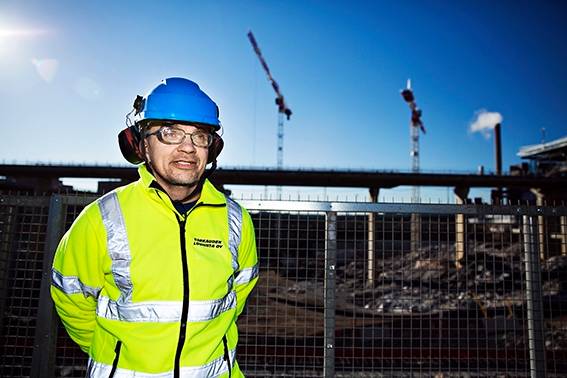
– In 1999 we had blue overalls and maybe hearing protectors, senior charger Jukka Kinnunen describes the safety gear he had at the beginning of his career.
A big bang during lunch hour
Although the construction site is only in its early stages, over 300 people work there.
The responsibility for the safety of the blasting rests with the blasting supervisor and the charger. Blasting is prohibited if there is even the slightest doubt that the guards have not guided everyone away from the danger zone.
– The work site has permission to blast between 7 am and 6 pm. But we decided to do the blasting during the coffee break and lunch hour, when the other workers except for the blasting gang were elsewhere. This makes it easier to follow safety precautions. During the blasting, the blasting supervisor is continually in contact with the metro, and he checks to make sure that the blasting can be done without disturbing the metro traffic. We report when the danger is over, says senior charger Jukka Kinnunen from Varkauden Louhinta Oy (Varkaus quarrying Co).
The enterprise undertakes blasting jobs as the subcontractor of Destia, which is responsible for the ground construction. There are some ten drillers and chargers at the site, and altogether over 80 workers are involved in the quarrying project.
Safety is of utmost importance in drilling and blasting, because the handling of explosives is always hazardous. On four consecutive years Varkauden Louhinta Co. has received the honourable commendation in the subcontractors’ series of the Uusimaa occupational safety competition. The title is awarded to three enterprises whose occupational safety is commendable. Jukka Kinnunen was chosen Charger of the Year in 2014, because he has demonstrated meticulous care in organizing and supervising the entire chain of drilling–handling of explosives–blasting–crushing of rock. At the age of 15 he started working at a construction site in a summer job as assistant driller and charger. In 1990 he graduated from Lappeenranta Technical School as a charger. Since then he has worked as a charger and supervisor of drilling and blasting at big construction sites in demanding residential environments, for example in Kamppi Centre and the Tapiola parking cave.
There are over 5000 excavation experts in Finland. Proposals for the Charger of the Year can be made by anyone working in the field, and the choice is made by a jury of professional colleagues.
The warning siren must always be heeded
Loose pieces of rock flying through the air are the biggest risk at construction sites where blasting is done.
– The blasting gang is very much aware of the hazards. The regulations have been tightened, job tenders contain detailed safety requirements, and hazards are listed in the risk analyses of work sites. Also the workers’ attitude toward safety is in order, says Heikki Thil, managing director of Varkauden Louhinta.
He is most concerned about getting other than professionals to understand that there is always a risk present in work where explosives are used. The general comment of people tends to be: “No rocks have flown from there earlier – why now?”
– The language barrier is a special challenge in the case of foreign workers. When we ask them to move farther away, they say “yeah, yeah”, but nothing happens. They don’t always understand the risks or even what is said.
– It is also more important than ever to inform the people in the neighbourhood about the danger, because blasting is often done in densely populated areas. When the blasting alarm sounds, people often rush to the window to see what is happening, although they should stay away from windows, says Thil.
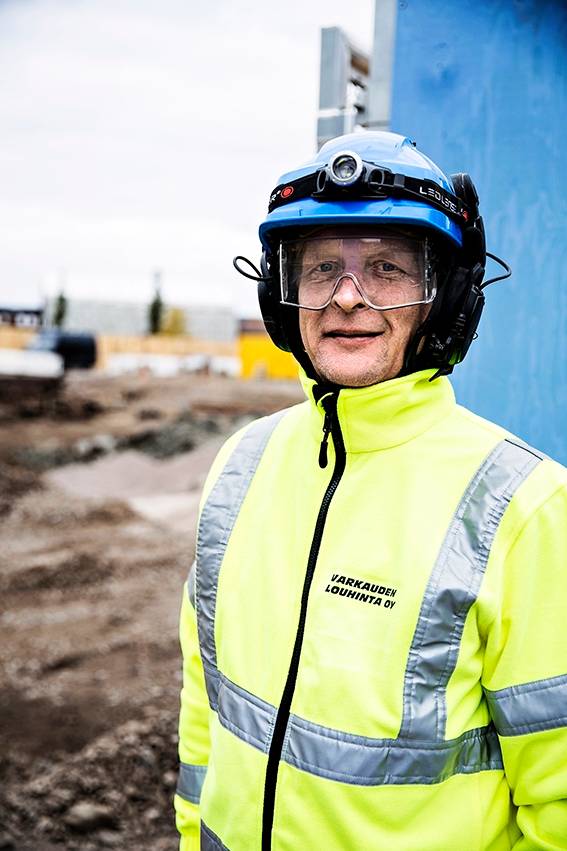
Heikki Thil says that the workers of the excavating enterprise take the hazards of blasting work seriously.
Triple-layered protective covering
On the day when we were visiting the Redi work site, an area of about 200 square metres had to be blasted. The triple covering for the blasting consists of 60 rubber mats made of truck tires, with a total surface area of 1000 square metres. The size of one mat is 18 square metres, and the mats are spread over the blasting area by caterpillars, so that their edges extend at least three metres beyond the actual explosion area.
Thil describes how still two decades ago only small manually handled mats were used. The mats were then covered with earth and felt fabric. There were not big enough machines at work sites for moving large mats.
Also the protective equipment of the workers is much better, and their use is now customary practice.
– When I started in 1999, we had only blue overalls and perhaps hearing protectors. No one used safety shoes or helmets, let alone brightly coloured attention garments and safety goggles, remembers Jukka Kinnunen.
But according to him, the work site supervisors still have to keep close watch to make sure that workers use the safety gear. For example, safety goggles may sometimes get fogged up, and the temptation not to use them grows.
Even more detailed safety regulations are on the way
The Ministry of Social Affairs and Health is presently drawing up specifications regarding the qualification requirements of chargers. The matter is being prepared in a work group including the central labour market organizations.
The work group has proposed that the vocational examination of chargers shall be broadened to include qualification certification for explosive workers in supervisory positions. The new certification will emphasize the planning and supervision connected with explosives work.
The safety level will also be improved by a proposition to divide the charger’s certification documents into more specific tasks, defining land work, underwater work and underground work. This would give persons with a certification document better readiness for their own specialized work areas.
It will also be decided whether those who apply for a charger’s certification will in future have to get approval also from the police. From the beginning of 2014 they have had to present a legal background check document.
The new law regarding a person’s background check will come into force in 2016 at the earliest. At the moment there are about 4800 chargers who have a certification document in Finland.
Zero accidents – a realistic goal
Five years ago Construction Industry stated as its aim “zero accidents in the construction industry by 2020”, the year when it will celebrate its centennial. Its sub-goal is to reduce accidents by 30% every year. At first this seemed possible, but then the improvement has slowed down.
Construction has traditionally been the most hazardous industrial sector. For one million work hours, there are 62 accidents leading to at least one day’s absence from work, while the average for all sectors is 29.
Enterprises can test their occupational safety level with the classification of the ‘Zero Accidents Forum’ of the Finnish Institute of Occupational Health. In 2014 altogether 37 enterprises obtained the acceptable level, of which 16 attained the highest level. One construction enterprise, NCC Rakennus Oy, South-Western Finland’s profit unit, was in this group.
These classifications have been applied since 2004. The number of enterprises that have reached the highest level has grown continuously. In the first year there were four. So far the record has been 23 in 2013.
Finland in the forefront
Tommi Alanko from the Finnish Institute of Occupational Health (TTL) is the leader of the Zero Accidents Forum. He says that safety in the workplaces that have joined the Forum has improved considerably more than in workplaces on average.
According to Alanko, many of the applicants to the Forum have attained the acceptable level. This is mostly because the applicant enterprises are motivated to improve their occupational safety and have made long-term efforts to do so.
– Improving safety at work also helps to develop the working habits and work culture of the enterprise. Alanko reminds that the motivation and productivity of the employees also improves.
Finland is clearly the pioneer in all of Europe when it comes to achieving the zero accidents vision. In many countries the situation in their national forums is the same as in Finland ten years ago, says Alanko.
– The most important achievement of the Forum is that enterprises now have access to a down-to-earth and efficient occupational safety network. Not all workplaces necessarily have many persons who are responsible for safety issues. Through the network it is easy to contact specialists in other enterprises, and to get help from them.
Alanko praises the open attitude of Finnish enterprises toward cooperation: they are willing to share their own know-how, but also ready to learn from others. An example of the power of networking is the Forum’s annual seminar which was attended by over 200 people.
In future, the Forum will extend the zero-accident approach. New areas will be: Zero occupational diseases, Zero tolerance to bullying, Zero work-related sick leaves, Zero overlooked violence or harassment cases, Zero cases of burnout, as well as Zero supervisors and employees who are not aware of occupational safety.
The net costs of one work day lost due to an accident amount to 27,880 euros.
‘Piku’ calculates the costs of a work accident
In addition to human suffering, accidents at work are expensive. The Finnish Institute of Occupational Health has developed the ‘Piku’ cost calculator, with which employers can calculate the economic losses resulting from an accident. The calculator illustrates the complexity of the costs. The average expenses are calculated based on the cost information on real accidents recorded in the Institute’s database.
The Institute’s accident cost calculator contains an example in which one day lost due to an accident costs 27,880 euros. In addition to immediate costs, this sum includes indirect costs such as compensation for absence, cost of damaged property as well as disturbances to production and costs of interrupted work.
One work day without an accident is many-fold cheaper. In the example calculation, the overall salary costs of one person are 326 euros per day.
A positive spirit lowers the risk of accidents
Occupational safety and psychosocial well-being go hand in hand, says psychologist Marita Hyttinen from 3T Ratkaisut Oy. She has developed a training programme ‘Inhimillinen turvallisuustekijä iTu – koulutus- ja valmennuspaketti’ (safety factor iTu – training package), which activates many people to participate in improving safety.
– Especially in high-risk sectors, more attention is being paid to psychosocial loading in the prevention of accidents. Even a minor slump in alertness can lead to a serious accident, for instance in aviation and in traffic, as well as in the chemical industry, Hyttinen says.
She points out that accident statistics reveal considerable differences even within one sector. For example, in the construction sector many accidents may happen in one enterprise, while another one may be nearly accident-free.
The central idea of Hyttinen’s safety project is to activate people’s own thinking and ways of coping with change. Another aim is to encourage people to understand the meaning of safety, to discuss it at work, and to give supervisors tools for managing safety from the iTu perspective. The iTu concept is based on recent research results in psychology and social psychology, and the project was sponsored by the Finnish Work Environment Fund.
The training package contains practical suggestions and educational material, suitable for all sectors. The program helps the work community to assess the present safety level at the workplace and to create a path for long-term safety management and development of a safety culture which takes into consideration the strengths as well as blind spots of individuals and the work community.
Simple practical measures
The iTu project has aroused interest, but according to Hyttinen, only very few Finnish workplaces have been ready to seriously invest in psychological safety measures. This requires concerted mental efforts from the entire personnel and a sufficient level of basic safety.
– But workplaces that do invest in safety from the viewpoint of the employees’ well-being, achieve good results: accidents and sickness absences decrease and the work culture is strengthened.
The practical measures can be simple: healthy nutrition, regular lunch breaks, and proper recovery. A tired person who has to work in a constant hurry starts to make mistakes, is vulnerable to accidents, and falls ill more easily. Big changes in work protocols have been achieved by implementing the model of early intervention throughout the entire organization.
Hyttinen emphasizes that although the legal responsibility for a safe and healthy work environment rests on the management and supervisors, every employee is ultimately responsible for his or her own safety. Everyone is also responsible for their workmates if their safety or health is endangered.
– Everybody gets many opportunities to demonstrate that safety is important. When people put their mind and heart to promoting safety, their motivation rises and they understand why they are doing it.
More information:
Inhimillinen tekijä haltuun!
UPA – Ulkopuolisten palveluntarjoajien turvallisuustoiminnan arviointi, TTK

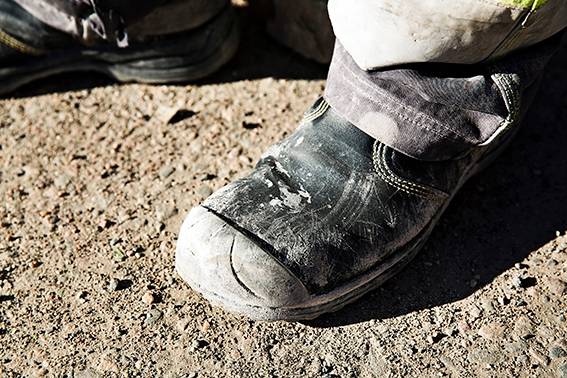
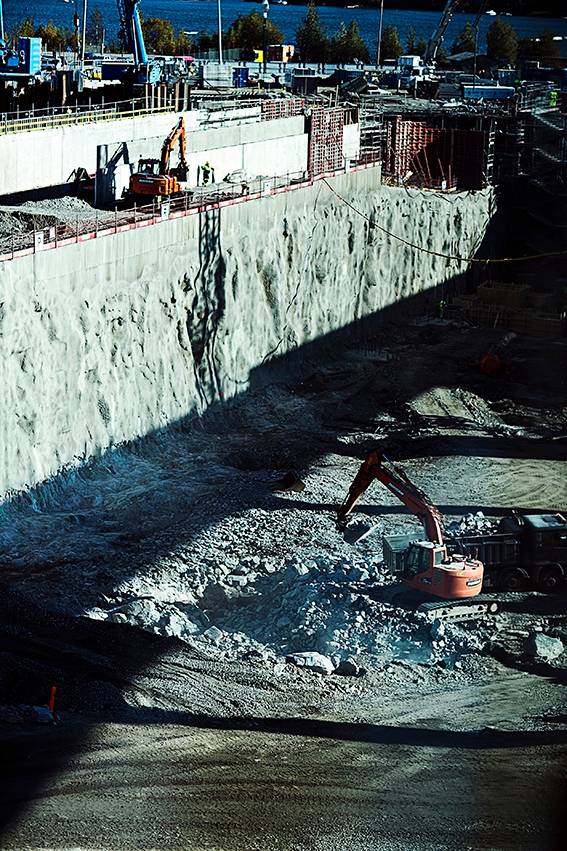
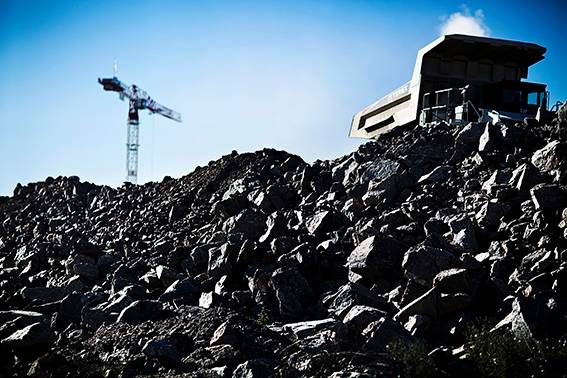
Kommentoi